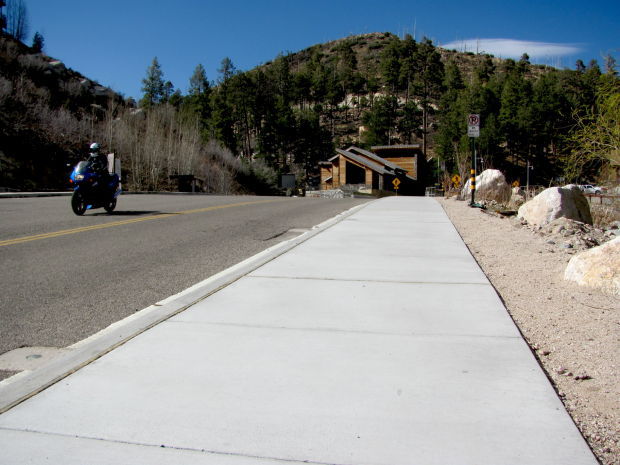The story about the UA’s senior vice president for health sciences taking chauffeured trips to and from Phoenix angered me just like it did everybody else.
Obviously, if Dr. Joe “Skip” Garcia wanted to work while he traveled, he should have just taken the train!
And, when I saw drivers plowing through rivers of storm water down Tucson streets Tuesday, I thought, “Why don’t they just take the dry, well-drained streets?!”
And when I see disabled people riding their scooters the wrong way in the bicycle lane down Speedway and other busy streets, I always think — “Why don’t they just ride on the sidewalks?!”
Yes, I’m being sarcastic. During my 2 ½ weeks of vacation in Minnesota and the San Diego area in late July and early August, the one thing that really stuck out to me — and I admit this isn’t flattering — was their infrastructure, and our relative lack thereof.
This really hit me when we were driving down U.S. Highway 169 from northern Minnesota toward the Twin Cities and stopped at the Rum River rest area.
First, it was surprising there was a rest area on any highway other than an interstate. Second, it was beautiful. The doors to the bathrooms were inside, and therefore the bathrooms themselves were climate controlled. There was visitor information, a walking path, a playground and, incredibly, a trail down to the Rum River used by canoeists. We could have spent the day there.
All this at a rest area on a secondary highway equivalent in size to Arizona 90 between Benson and Sierra Vista.
A week or so later, we were driving from San Diego back to Tucson on Interstate 8. Of course, the first rest area in Arizona, called Mohawk, was closed. It has been for as long as I can remember. That reminded me of when we were driving back from the Chiricahuas in April: The first rest area along Interstate-10 coming west from New Mexico, the San Simon rest area, has also been closed.
(ADOT tells me the Mohawk rest area is being remodeled and San Simon has re-opened since I passed through, though it has had a flooding problem.)
These are relatively minor items in a state’s budget, easily targeted when money is tight. And it is very tight in Arizona, thanks to our self-imposed austerity.
Our operating budget this fiscal year is about $10 billion; Minnesota is spending about $20 billion per year. Oh, and it has about 1 million fewer residents than Arizona. These budget figures aren’t a perfect apples-to-apples comparison, but per-capita-spending rankings show Minnesota spending about 50 percent more per-person than Arizona.
No wonder they can afford 56 — yes, 56 — rest areas scattered around the state compared to Arizona’s 22.
And no wonder the passenger train that Dr. Garcia should have been taking between Tucson and Phoenix — like the well-traveled trains between Los Angeles and San Diego — does not exist and likely never will.
The Arizona Department of Transportation has been studying rail between the state’s two biggest cities for years and is moving forward. But eventually we’ll get to that place where the billion-dollar project needs to be funded.
Unless the federal government steps in and funds most of it, I don’t see the support materializing. In Arizona, we just don’t spend money on massive infrastructure like that these days.
But it’s not just the state’s infrastructure that lacks. As becomes clear every time we have a heavy rain, our local infrastructure has problems, too. This isn’t the fault, generally, of the current occupants of office. It’s the result of decades-old bad or delayed decisions.
Here, I’m thinking of decisions like building North Alvernon Way and other streets in such a way as to funnel water, rather than shed it. Designs drawn decades ago can only be fixed through massive public works.
Those wouldn’t even be included in the $700 million that City Manager Michael Ortega said is necessary to repair Tucson roads.
“The reality is we have a lot of unmet needs. How do we deal with it — address those systematically over time and in partnerships,” Ortega told me Tuesday.
The same is true of another of our great lacking pieces of infrastructure — sidewalks. As we all know, the average Tucson-area neighborhood has no sidewalks. That endangers pedestrians, especially children, and discourages people from walking, contributing to our societal health problems.
This resulted in part because of the way the city developed. After Tucson began requiring streetlights, storm sewers and sidewalks in the 1920s, developers began building just outside city limits, Tucson historic preservation officer Jonathan Mabry said. Then the city would annex the developments with the infrastructure lacking.
Whoever is to blame, we’re left with the deficit.
“Now the city is working to retrofit the older urban core with those amenities,” Mabry said.
However, the city itself isn’t putting much effort into the sidewalk issue — there is no current capital plan to build new sidewalks. It’s left that to the Regional Transportation Authority, which is building 250 miles worth of sidewalks in the Tucson area as part of its 20-year plan. Those are all along busier streets, not within residential neighborhoods.
Now, there is some hope federal help will be coming. Both Hillary Clinton and Donald Trump have promised major infrastructure programs if they are elected. We could use the help, obviously!
But my travels tell me it’s best not to wait for that — and definitely not to wait for the state of Arizona. Last year, Phoenix passed a sales-tax increase, lasting 35 years, that will help pay for $30 billion in rail and other transit improvements.
We’ve seen what happened with Tucson’s road bonds — they’re helping tremendously. What’s clear is, if we want things, we need to build them.





